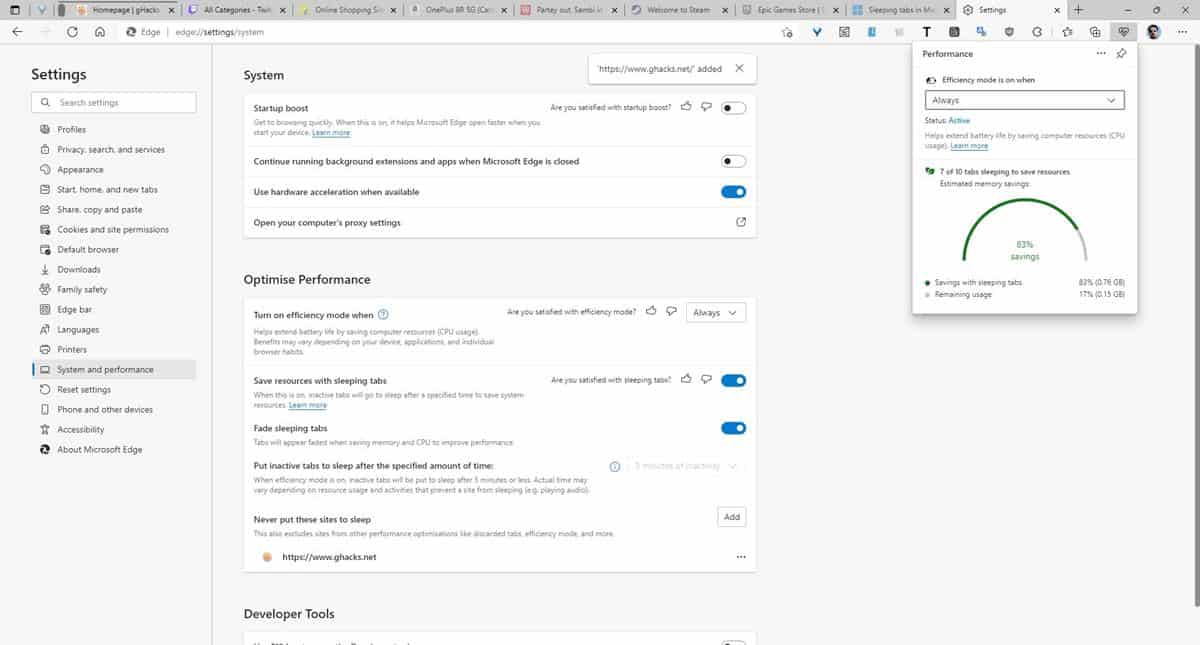Microsoft Edge 100 improves the ability of Sleeping Tabs to save more resources
Microsoft Edge 100 was released a few days ago and is essentially a security update. The Redmond company has highlighted that the latest version improves browser performance with a more optimized version of Sleeping Tabs.
The feature debuted in September 2020, when Edge Canary 87 was released. It was rolled out to all users in Edge 89, in March 2021. As you browse the Internet and accumulate multiple tabs, the browser begins to consume more resources, which resulting in a drop in system performance. Sleeping Tabs monitors the tabs you haven’t used for a while, i.e. inactive tabs, and automatically snooze them. This is also called Tab Download, Tab Discard, or Tab Suspend. Edge isn’t the only browser that supports it natively, it’s also a feature you can find in Google Chrome, Mozilla Firefox, Opera, and Vivaldi. Waterfox G4.1.0, which was released yesterday, added tab downloading and allows you to snooze tabs manually. Brave Browser is the only one that doesn’t support Tab Snoozing natively, but that can be easily fixed by using an extension like Auto Tab Discard.
I think we can agree that Sleeping Tabs is a useful feature and Microsoft Edge 100 makes it even better. The company’s announcement says that Edge will put 8% more tabs to sleep, to save more resources. How does it work? Pages that share a navigation instance with another page will be suspended. This allows Sleeping Tabs to save up to 85% memory and 99% CPU usage on average. Changing the efficiency mode in the Performance pop-up panel to “Always” will snooze tabs faster.
That’s pretty impressive, and if you’re interested in doing calculations, you’ll probably like this. Edge 100 has added a new performance monitor so users can see how Sleeping Tabs helps save system resources. To access it, click on the three-dot menu and select Performance. This will open a pop-up showing the number of tabs that are inactive and a graphical indicator to show you the percentage of memory saved with inactive tabs and remaining usage. You can pin performance monitor to stay in the loop, to monitor resource usage. It’s a decent way to monitor the system, although Windows Task Manager still beats it as you can get a breakdown of resource usage by tab.
There is no option to manually put tabs to sleep, although users have requested the feature in Microsoft’s feedback hub. You can whitelist websites in the Optimize page performance section of edge://settings/system. This will prevent Edge from postponing site tabs, can be useful for sites you use for email, instant messaging, sports websites that auto-refresh to update scores, etc. You can set tabs to snooze after a specific duration, for example 5 minutes. Alternating the
Don’t you like the function? You can disable Sleeping Tabs in Edge from the Settings page.
Edge 100 also brought some new features, such as the ability to preview PDF files using File Explorer and Microsoft Outlook powered by Edge’s Web View, and support for viewing digitally signed PDF files.
advertising















